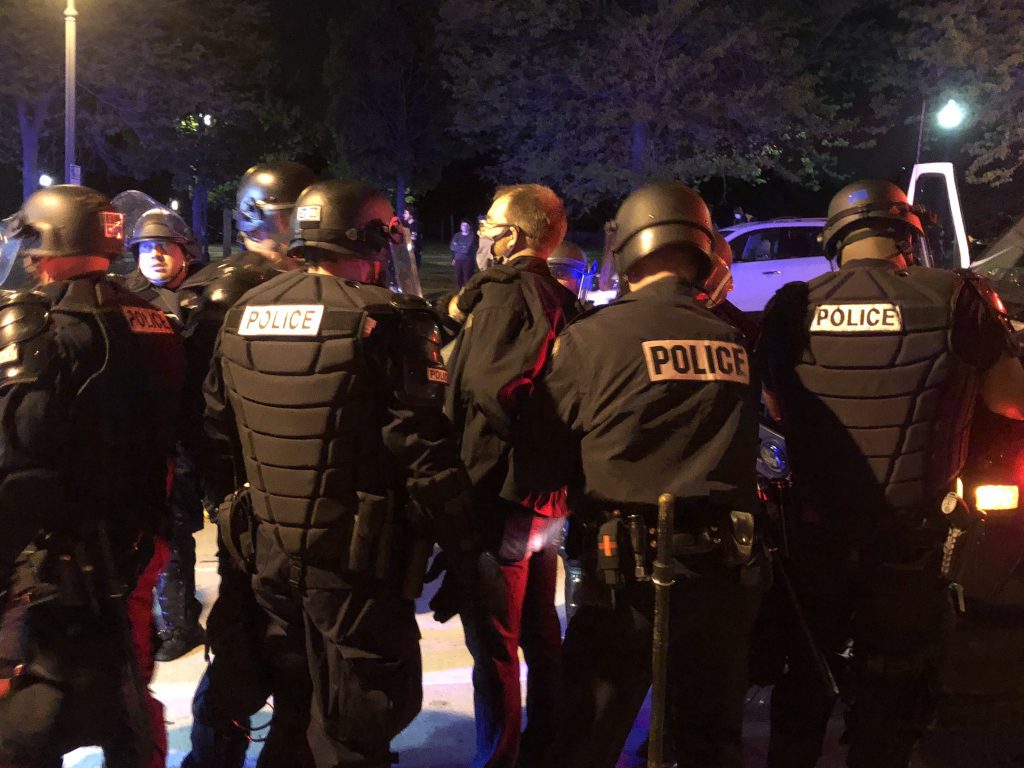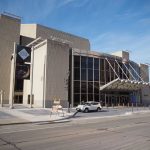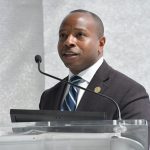City Officials Grill Police on Tactics
Still more questions on 6th and McKinley, as council, mayor disagree with police tactics.
A three-hour meeting Friday afternoon between the Common Council, Mayor Tom Barrett, Fire & Police Commission and Milwaukee Police Department revealed substantial frustrations with overseeing the police department and its response to protests.
The meeting covered a broad swath of topics including the looting on Friday night, the three-day curfew, police response at 6th and McKinley on Tuesday and police tactics and strategy regarding marches.
Mayor Barrett used his 10-minute opening remarks to explain that he thinks the curfew was initially the right decision, and that it was also the right decision to stop it. “The execution of it is another question,” he said. “My view was this was going to be used as an educational tool.”
In light of the ongoing pandemic, Barrett raised concerns about individuals being held in custody in close proximity for long periods of time and how they were treated. Those are issues Milwaukee County Supervisor Ryan Clancy, one of 165 people to be arrested for a curfew violation, raised in an interview with Urban Milwaukee earlier this week and other individuals raised in the hundreds of letters submitted in advance of the meeting. Committee chair Marina Dimitrijevic encouraged the public and police department to read through the letters to understand what the perception is.
Assistant Chief Michael Brunson, filling in for Chief Alfonso Morales who was at a community walk and then a press conference, said the use of rubber bullets and tear gas is a change from police practices in the 1960s that resulted in deaths in many encounters. The city now uses a Major Incident Response Team, which is the convoy frequently shown in video accounts. “Law enforcement options at those times [the 1960s] were a handgun and a billy club,” said Brunson. “The MIRT unit was created to use the minimal amount of force to get the situation under control.” He said the team is federally trained. “We are doing our best to defend the city.”
But Barrett isn’t the only one concerned with how things are playing out. Numerous Common Council members expressed frustration and asked questions about how things are escalated when the team is involved with the protest marches, most notably at 6th and McKinley.
Brunson said he respects the right to peacefully protest, but MPD is dealing with another element. “We have had five police vehicles struck by gun fire,” he said. “A total of 43 businesses were looted on that first night alone.” Urban Milwaukee, however, has not received an update on vandalism and looting statistics since Monday. A department representative promised a spreadsheet.
The Assistant Chief said he believes it was a criminal act by the Minneapolis officer that killed George Floyd.
“There needs to be a recognition from the police department of what’s motivating people in these protests,” said Alderman Ashanti Hamilton. “There is the spark of George Floyd that sparked this across the country, but I think the motivation that keeps people coming out day after day has been the relationship that they have had with their own police department in this city.”
Hamilton said he’s been out in the protests, undercover in a mask and hat, and has seen the police worsen the situation. “I’ve seen disbursements of crowds that actually exacerbated the situation when it would have been easy to remove the provocateurs,” he said.
Brunson said at least 98 percent of protesters are peaceful, but others have thrown items at police officers.
“I have seen that, but I also have seen police action escalate things,” said Hamilton. “So I want that acknowledged and I want that addressed.”
Ald. Scott Spiker asked questions surrounding how the police get to use force, particularly regarding the incident at 6th and McKinley. “I assume throwing [plastic] water bottles when you’re in riot gear wouldn’t cause a bodily threat.”
“There is a ton of oversight in our use of force in civil disturbance type situations,” said Brunson. He later said that from a command center he authorized the use of force in the 6th and McKinley incident. The Assistant Chief noted that a “long-range audio device” (a loudspeaker) is used to announce an unlawful assembly multiple times before force is used. “We make that very clear before any engagement.”
“At 6th and McKinley, that was quite a warm day,” said Spiker. “I don’t think that’s quite the concern on that day.”
“The bottom line is citizens should not throw objects at the police. Period,” said Brunson. “Obviously,” responded Spiker. But he continued to ask if there is a middle ground that could remove the provocateurs without using force on the other marchers.
Alderwoman Chantia Lewis asked what has been done regarding the officer that put a knee to the neck of Cameron Murdoch, a cyclist at the front of the protest who was arrested during the incident. “The officer has not been pulled,” said Brunson. “From what we’ve seen so far, and in looking at this individual officer, it does not fit our criteria for pulling him and assigning him to administrative duties.” Brunson said the criteria includes either a serious crime or a threat to the community.
“To me, we would be erring on the side of caution and saying ‘this is the exact type of behavior we are having issues with and we don’t condone,'” said Lewis of the officer hitting Murdoch and kneeing him when he was on the ground. “So why not at the very least pull that officer from duty? And to hear that it’s not warranted is troublesome to me.” She said the city should review the standard operating procedure that allows that.
Ald. Nik Kovac asked what the police department thought about its response at 6th and McKinley. “The position of the Milwaukee Police Department is that we review every use of force for violations of our policy,” said Brunson.
“From the video we have shown so far, and we have shown some of that footage, members of the crowd were throwing objects at officers,” said Brunson.
“I think the time frame just doesn’t match that justification,” said Kovac. MPD reported that a “Molotov cocktail” was thrown after 8:00 p.m., but video shows the police already engaging with force over a half hour earlier.
Does that Molotov cocktail actually exist? “The [Bureau of Alcohol, Tobacco, Firearms and Explosives] is investigating that right now,” said Brunson. An MPD representative said the ATF is examining a single bottle.
“I think that is a specious justification,” said Kovac.
Brunson said MPD officers primarily used smoke, not tear gas, but did confirm rubber bullets were used. He said assisting departments could have used tear gas.
“The response was inappropriate and extremely disproportionate,” said Kovac, who has been spotted at multiple marches. He said he wanted to hear a mea culpa from the department on the incident. “That’s not what I’m hearing and I’m profoundly disappointed.”
The alderman asked the department to scale back use of a Wisconsin National Guard helicopter to monitor the protest marches; at least one MPD member flies with the guard on the Black Hawk helicopter. He said understands department is addressing issues in other areas, away from protests.
“I think it is well out of proportion, I think it sends a completely wrong message about a cause you say you support,” he said.
In response to a question from Alderwoman JoCasta Zamarripa, Brunson said the department’s response has not been flawless. “Have we made perfect decisions at every time? Absolutely not,” he said. The Assistant Chief said review would lead to future improvement. He said the department has “respected the rights of citizens to protest in this community.”
“I keep hearing that ‘you all used tear gas and rubber bullets on peaceful protesters’, and that is just specious first of all and not accurate,” said Brunson. “I want someone to bring up incidences other than 6th and McKinley.”
Kovac had earlier brought up the incident near N. Port Washington Rd. and W. Capitol Dr. at approximately 3:00 a.m. Tuesday morning that Urban Milwaukee was blocked from observing by the police, but Brunson said that incident is under investigation. Four protesters in separate interviews told Urban Milwaukee they were cornered and had gas deployed on them. Spike strips were also used. “We did arrest some individuals that were driving recklessly,” said Brunson.
What Can Be Done?
Milwaukee’s police and fire departments are overseen not by the city’s elected officials, but by an independent Fire & Police Commission made up of part-time commissioners. The members are appointed by the mayor and confirmed by the Common Council. Mayoral appointee Griselda Aldrete administers the full-time staff, of which approximately half of the 28 positions are vacant.
The commission approves standard operating procedures for the departments, hires and fires chiefs, investigates complaints and administers discipline.
Aldrete told the board that the commissioners could open an investigation and conduct a trial on the matter.
How does such a thing get started? Aldrete said individuals could call 414-935-7942 or email MPDIAD@milwaukee.gov. “I assume you’re going to get a lot of those right away,” said Kovac.
The Executive Director has already moved to extend the comment period on the six-month performance review on Chief Morales. It was previously scheduled to end on Friday, June 5th, but is now open until June 12th.
Only seven of the nine slots allowed under state law are currently filled. The term of one still-active member, Ann Wilson, expired in 2017.
Council President Cavalier Johnson, in brief remarks interrupted by technical difficulties during the virtual meeting, said the city needs to move forward addressing the “8 Can’t Wait” initiatives being discussed across the country. The proposal includes banning chokeholds, requiring de-escalation, exhausting all alternatives before shooting, warning before shooting, no shooting at moving vehicles, requiring officers to intervene on forced used by other officers, use of force policy restrictions and comprehensive reporting.
What’s The Plan for King Drive?
“Why has MPD chosen not to engage on King Drive?” asked Ald. Milele A. Coggs. “The couple times you all have is after a fire has been burning, when people are on roofs, and then you come in with tear gas and bullets.”
Brunson said the department has had to use substantial manpower to protect the district five station at 300 W. Locust St., near the intersection of N. Martin Luther King Jr. Dr. and W. Locust St. He said the station was under attack on Friday. It is now guarded by a number of members of the Wisconsin National Guard alongside the police department.
“Let’s not talk about Friday, let’s talk about every other night,” she said.
“We’re not ignoring King Drive,” he said. “It feels like that,” Coggs responded.
Coggs asked for King Drive to be closed to street traffic in the evenings to de-escalate the situation.
Brunson said the city has protected the nearby stand-alone Burger King, especially when people were on the roof on Tuesday. “I don’t know if you or anyone else was aware of that,” he said.
But Coggs is concerned about the many first-floor businesses lining the street. She asked for King Drive to be closed to motor vehicle traffic in the evenings to de-escalate the situation, a request that multiple sources indicate she has made privately in the week prior. “It’s just to stop cars from coming through at night, I just want that on the record publicly,” she said.
Just before 10:00 a.m. Saturday, MPD announced the closure of King Drive to vehicle traffic from W. Center St. to W. North Ave. starting at 3:00 p.m. Saturday and Sunday. W. Center St. at King Drive is closed indefinitely.
Reggie Moore, director of the city’s Office of Violence Prevention, told Urban Milwaukee in an interview Thursday evening that he also believes the Harambee neighborhood is being under policed.
CORRECTION: An earlier version of this article said Kovac supported use of helicopters in other areas of the city to address looting. He said he understands there are looting issues in other areas of the city, away from the marches.
If you think stories like this are important, become a member of Urban Milwaukee and help support real, independent journalism. Plus you get some cool added benefits.
More about the 2020 Racial Justice Protests
- Plea Agreement Reached On Long-Pending Sherman Park Unrest Charges Involving Vaun Mayes - Jeramey Jannene - Oct 17th, 2024
- Rep. Ryan Clancy Settles With City Following 2020 Curfew Arrest - Jeramey Jannene - Dec 12th, 2023
- Supervisor Clancy Applauds Settlement in Clancy vs. City of Milwaukee - State Rep. Ryan Clancy - Dec 12th, 2023
- Tosa Protest Assails Federal Court Decision Exonerating Police - Isiah Holmes - May 9th, 2023
- Wauwatosa ‘Target List’ Trial Begins - Isiah Holmes - May 3rd, 2023
- Shorewood Spitter Found Guilty For 2020 Protest Confrontation - Jeramey Jannene - Apr 20th, 2023
- City Hall: City Will Pay 2020 George Floyd Protester $270,000 - Jeramey Jannene - Feb 14th, 2023
- Tosa Protest Tickets Dismissed - Isiah Holmes - Jul 21st, 2022
- Op Ed: ‘We Need More’ - Charles Q. Sullivan - Mar 4th, 2022
- Milwaukee Officers Circulate “2020 Riot” Coins? - Isiah Holmes - Nov 14th, 2021
Read more about 2020 Racial Justice Protests here
Political Contributions Tracker
Displaying political contributions between people mentioned in this story. Learn more.
- April 4, 2016 - Milele A. Coggs received $97 from Reggie Moore
- January 25, 2016 - Chantia Lewis received $100 from Reggie Moore
- May 7, 2015 - Nik Kovac received $10 from Cavalier Johnson






















